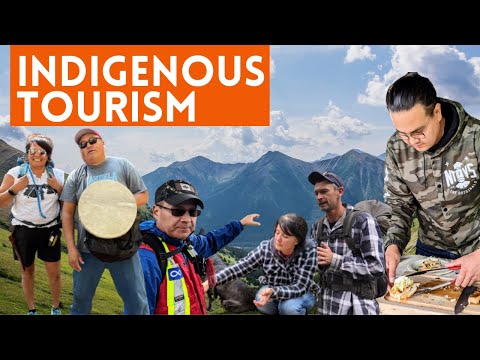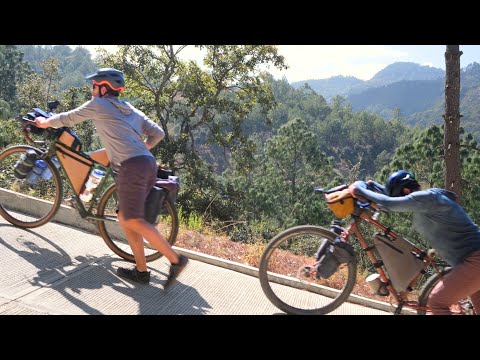5 Incredible INDIGENOUS Tourism Experiences in Canada | Alberta Travel Guide

Hello from Alberta. That's right. I haven’t traveled outside the Maritimes in 18 months. But this is my first trip. I am in Alberta and very excited because I'm working with Indigenous Tourism Alberta. So, for the next five days, I'm traveling from Calgary to Edmonton and I'm going to be checking out several of their Indigenous tourism experiences.
I think it is going to be really eye-opening to see things. To see the province from a completely different perspective because you could just take a walk to a waterfall with a guide. But what if that guide was Indigenous? What do they bring to it? I think this is going to be a trip that I'm going to remember for a long time.
And can you tell me again what it's called Kakike pakwa. And what does that mean? Forever leaf tea. Is it sweet or more tart? It's like sweet, but also a bit tart. There's usually two types. There's either like it's this color or it's white underneath.
You don't want to pick the white ones, are they just not good? There's a little...they say they're poisonous, slightly poisonous. So these are different than the bog cranberries. All these are the bog cranberries.
Yes, these are really good. A little bit bitter on the end. Yeah. Just arrived at where we're going to cook some food. And I've got to say, we went by all of these bison.
They are gigantic. This place is gorgeous. So my name is Scott Iserhoff.
I'm from the Omushkegowin First Nations, which is a small remote reserve in Northern Ontario. And I'm founder of Pei Pei Chei Ow catering company and now education company. And we talk a bit. Starting this journey.
I was just, I was just a cook at the youth empowerment support services. It's a youth shelter and I, we were getting calls to cater some events. And I'm like, okay, I'll do this, but I'm not a cater, right? So I booked some time off and then after that, I was contacted by the City of Edmonton and our Government of Alberta. And then it just snowballed from there. Where I had to start saying, no to some catering gigs.
And eventually me my wife had this discussion of quitting my full-time job, and pursuing this as my main career. What did you do full time before? I was a chef for 15 years. So we're gonna make fry bread. Cool.
So, what is your favorite food? My favorite food is smoked duck. Smoked goose with anakhanaow. So so it's a type of bannock but you do it like dumplings. Medium rare. And you can just cook it in the bone.
Yeah. Yeah, I always thought you needed an oven. Like, these are very thick bones here. This is just pancetta parsley stem and lemon zest.
That's just gonna go on the top. So where would you like to see this business go? That we have a restaurant. And my vision was to have a fully Indigenous profession. Not just Indigenous owned, because there's a lot of Indigenous businesses that have like white folks in them. To me it's just like the devil went chef at an Indigenous restaurant.
It’s not Indigenous to me. So have like an Indigenous in front of house doctors, back of house, and like everyone Indigenous. And then like educating people about Indigenous isn’t homogenous. Teaching about the different perspectives. We do a pay-what-you-can class. So we invite a chef to show their perspective and Indigenous chef to show their perspective of food.
And it's completely different from my perspective. A lot of people, they're like why I didn't realize that. You would have different experiences in life. And it's very regional. Cooking is very regional.
That's interesting. Yeah. I think I really like your perspective of sharing that it's not homogeneous, it's not just like the Indigenous People of Canada. Yeah, it's not just bannock, you know. Welcome you to Treaty 7 Territory, traditional lands of our Black Foot Confederacy, which is Siksika, I’m Blood and Piikani, Aamsskáápipikani Piikani, which is across border in the United States.
Also to this territory is the Tsuut'ina and the Stoney Nation and First Nations here. So we are very honored to be out here. This is our background, our playground, where we're able to connect to the mountain spirits, to the plants, to the animals and everything here. There's so much that we’ve learned to embrace as our Indigenous culture.
To always give thanks to, we could take but, we always have to give something back. And so we acknowledge this morning by offering the tobacco. And as we walk we have different plants that we use out here for, you know, traditional purposes we're allowed to harvest. So we could pick our our natural medicines. The stuff we use to pray with, in our prayer family. But we always have to give back.
So we only take, we only take what we need. Okay, we got a little buddy here. He wants to listen as well.
And he’s wanting a peanut. Yeah but if you kind of sit down and you kind of put your hand out he’ll come on. So this is a little amazing man made...oh, and the reason why it's called Troll Falls is you will see trolls and then around on the trees, the dolls.
Yeah the dolls. Oh, wow. So, you'll see trolls around, I haven't seen any yet, but this is pretty cool because you could go in. Do you know who makes this? Just anybody, so we have fallen trees, they come out and they put them in.
Make use of them, yeah. Oh you can walk through this one. Yeah, it’s way back. And I made it to the Painted Warriors Ranch.
I have really been looking forward to this. I'm here all afternoon, trying a number of different activities. Staying for dinner, staying the night in a trappers tent. It was supposed to rain today and somehow the sun has come out and the weather has changed. I am so excited. So today’s experience on the horses really is about connection.
Today was such a big day. I would say, a few years ago, I decided I was never going to ride a horse again. I just had so many bad experiences on like trail rides and not feeling like the horses were well taken care of, or I didn't feel in control of the horse. And so today, when Tracey said to me, oh we're gonna learn to ride a horse.
Do you want to do it? I thought okay this experience could be a different experience. So now what's really interesting, this brown and white one that you see right here. This paint horse. Even though he's kind of more in the middle of the pack, he's the one that they follow. He's the one that decides where they go, even though he's not technically the leader.
So I'm going to say yes to this and I am so glad that I did. So, the Cree People are known to have great relationships with horses. And Tracey took me through such a unique experience of, instead of just hopping on a horse to say okay, we're gonna go for a trail ride. We first went out to see the horses and observe them. All righty. And then we led them back to the stable.
And when you get to walk, catch and lead your own horse back that’s the starting of making that connection with a horse. Right. And then we led them back into the stable. And then we brushed them again to kind of establish a relationship. Put the saddle on.
I learned how to do that. And then actually started inside. So I could have a relationship with the horse before we went outside.
So I've never really felt comfortable around horses and this changed everything. So, instead of just hopping on a horse and like, hoping for the best, you actually get to know the horse and it gets to know you. And you feel so much more comfortable. It was just really an amazing experience, and her respect for the relationship with the horse. It changed my opinion of riding horses again. It’s wonderful if you can bring out this.
It's just kind of an easy way to learn how to use this and get a fire going. Yeah. Okay. Oh wow. So you got a fire going.
And what I like about this is you got the flame working for a long time. So you have kind of timed work with it. You have a big enough flame that the wind's not going to put it out right away.
Right. Yep, it's right. A little bit closer to that cotton ball. YES! This is amazing.
I did that! Lit my first fire. It only took 10 minutes. I traveled to Sundre to meet with Jordan, from Mahikan Trails.
We went on a plant and medicine walk and I learned so much. He gave me practical advice about bears. Avoiding them. And why some bear attacks happen. And this plant is the leading cause of bear attacks. Oh, okay.
So it's this one right here. This one right here, buffalo berry. Now this one doesn't have any berries on it.
It did a few weeks ago, but the reason that it's the leading cause of bear attacks, is any areas where we have this plant? It's their primary food. So they'll have a pea sized, orange or yellow berry and in order to put on the weight to make it through the winter each bear needs to eat around 250,000 buffalo berries a day. And the reason that it causes attacks it's not so much them defending their food source. Yeah. Because I have to eat so many, they're so focused on the berries that they're not paying attention to anything else.
So even though they have really good hearing, really good sense of smell and their eyesight is almost as good as human eyesight. They're so focused that they won't notice you. And even though they're large animals, it's surprisingly difficult to spot in the wild. So you won't know the bear is there.
And you keep walking and getting closer. And then once you in the bear become aware of one another, you're too close and it may feel that you need to defend itself. My great-grandmother, she lived in a remote area, in kind of northern Alberta. And they’d onlyt get a doctor coming out from Edmonton once a year. So generally it was her job to keep everybody healthy.
Nowadays, things like colds, flus and pneumonia are kind of no big deal. But if you go back far enough that could be life threatening. And if somebody came to her because they couldn't cough, they couldn't clear their lungs.
They were completely blocked up. She’d take the sap, heat it up to a little bit warmer than body temperature. So just enough to fully liquefy it, smear it on the person’s chest and then take a piece of tan hide from the shoulder of either a moose or bison. And the reason the shoulder, is that's the thickest part of the hide. It protects the animals during the rut so they don't get punctured by a horn or antler.
And the thickness of the hide was important for protecting the person from the next step. So she put the hide on the chest, over top of the sap, then take rocks out of a fire and put them on top of the hide. And the heat would force the vapors into the person's chest and then she'd flip them around. Again do the same on their back, then on the chest, then on their back.
And all the while kind of beating on their sides occasionally to help move things and clear out their lungs. Wow. It's wild rose and these are the rose hips. They're starting to ripen.
If you were to eat a rose hip right now it's kind of bland. But pretty soon when the nights get cold enough, that we get those good hard frosts, they start to sweeten up. It was also, it's also another source of vitamin C that is available in the winter. Although obviously not as abundant as the spruce and pine needles. But it tastes better.
And so you said this will taste a little bit bitter. Oh it's bitter on the end. At first you taste a little bit of sweetness and it's like astringent.
He blew my mind with how many plant remedies existed in the forest all along before recent medicine. There's just so much we walk by without knowing how powerful it is. But the truth is the knowledge, was there all along with the Indigenous Peoples. We just weren't listening. It's a little bit rainy out, but that's not going to stop me.
I'm here to meet Keith from Talking Rock Tours. He's a Métis geologist and tour guide and we're heading into Edmonton's Famous River Valley. Welcome everyone. This is the Edmonton River Valley Discovery Tour. My name is Keith Diakiw and I'm a proud Métis geologist and tour guide.
I have a physical geography degree and an anthroarchy degree. Then added the geology here at the U of A. And it's great to have the opportunity to kind of share the River Valley Discovery Tour because again the everyday person that lives here in Edmonton, don't even know the history. The stuff that's actually in plain sight.
And that's why I take people on this journey. I essentially started the tour last year. Keith has so much knowledge.
Not only is he a geologist and has a passion for the city and its history. But he shared with me so much of his own Métis heritage, from the tobacco offering in the beginning and smudging before we started the tour. And I really feel like you could take a tour with anyone, but when you take a tour with an Indigenous guide, you see the city in a completely different way. And so he shared with me a lot of his heritage and his own story about embracing this side of him.
And so, you know, he says he has the best of both worlds, being Métis and really brought both of those things into the tour. It was really great and those three hours flew by. Our beautiful red white and maple leaf you know, flag is only five years older than I am. And when you think for this flag to be flown into battle in 1816, you can see this is Canada's first patriotic flag.
It's not the Union Jack and it's not our maple leaf flag. It's the Métis flag. He does customize them so if you’re really interested in geology or you're really interested in Indigenous culture, you can choose, kind of choose your own adventure of what you would like. I really thought learning more about the Indigenous culture in Edmonton, which has a second largest group of Indigenous Peoples, was fascinating. There's so much here that I never knew about even though I've been to Edmonton before. It was really cool.
So the Grey Eagle Resort and Casino is at the doorstep to the Rockies, just outside of Calgary. I'm not a gambler at all but the casino and the hotel are actually separate buildings. So on the hotel side, I did see a lot of families. Kids going to the pool here. Guys the artwork here is gorgeous.
There were so many pieces I would love to take home. So whatever you're looking for even if you're not a gambler, this is a great hotel. All right. So here is my room at the resort.
So we head out. Great artwork. Look at this, a very big room. I feel like I should probably try to exercise tomorrow morning or something. So at Grey Eagle Resort and Casino there are a number of places that you can eat. I wanted to try Blaze Bar and that's because they had a local bison lasagna, and I think that's sounds amazing.
I love bison. I love lasagna, the two of them pair perfectly. Lots of things on the menu. They actually had a lot of pan Asian foods that looked fantastic, but I knew the lasagna was going to be big. And it's certainly is big, because it's not only lasagna, but it also comes with a giant garlic toast.
You're not going to be hungry after eating this. In fact, I think this might be my dinner and maybe my breakfast tomorrow too. Okay, the tomato sauce? Super rich. Oh and this bison is so good. So there are two spots to eat here.
There is a sports bar inside the casino, but I've really wanted to eat at The Ridge, which is a family style restaurant, because it has some really interesting dishes with local game. I decided to get the Stoney Charcuterie board and that is because it has elk salami, a cured buffalo pepperoni, wild boar terrine. This charcuterie board was calling my name. And so I'm going to try the elk salami first. Now, elk would be a fairly lean animal. This is so good.
Oh, just a little bit peppery, lean. Oh, this is fantastic. And then we've got the cured buffalo pepperoni. Oh, this is so good.
Also very peppery. It does taste a little bit like pepperoni, but a lot better. Just very rich and smooth.
2021-10-27 07:14


